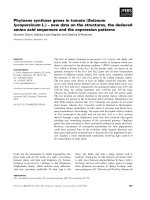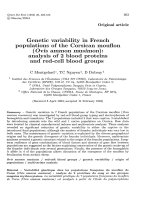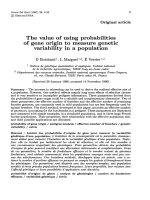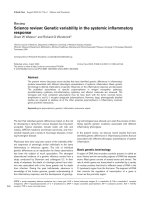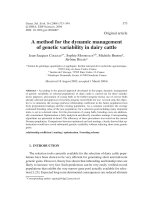Genetic variability in Brinjal (Solanum melongena L.) under Konkanagro climatic conditions
Bạn đang xem bản rút gọn của tài liệu. Xem và tải ngay bản đầy đủ của tài liệu tại đây (163.4 KB, 5 trang )
Int.J.Curr.Microbiol.App.Sci (2019) 8(10): 1372-1376
International Journal of Current Microbiology and Applied Sciences
ISSN: 2319-7706 Volume 8 Number 10 (2019)
Journal homepage:
Original Research Article
/>
Genetic Variability in Brinjal (Solanum melongena L.) under
Konkanagro Climatic Conditions
V. G. Magar1*, P. C. Haldavnekar1 and P. G. Magar2
1
Department of Horticulture, Dr.BSKKV, Dapoli, India
2
Department of Horticulture, Dr.PDKV Akola, India
*Corresponding author
ABSTRACT
Keywords
Genetic variability,
Brinjal, Konkan
Article Info
Accepted:
12 September 2019
Available Online:
10 October 2019
In this research fifty F4 progenies of brinjal were subjected to study the extent of
variability present in the experimental material. Analysis of variance indicated
presence of large variability for different characters under study. Most of the
growth, flowering, fruit and yield characters under study were found significantly
varied. The magnitude of phenotypic variance was greater than genotypic variance
in all the characters under the study. The magnitude of the genotypic variance was
greater than environmental variance for most of the characters except days to last
harvest, days to first harvest and harvesting span. High heritability values were
obtained for most of the characters studied except days to last harvest, days to first
harvest, harvesting span. The highest estimates of genetic advance were recorded
in fruit weight. Similarly the high values of genetic advance accompanied by
higher heritability were observed for the character fruit weight. Genotypes 86 and
88-7 for earliness, 60 for maximum length of fruit, 57 for maximum girth and
maximum weight of fruit, 62, 64, 72 and 88-2 for maximum harvesting span, 62
for maximum number of fruits, 62 for maximum number of fruit per plant, and 71
and 61 for yield were found promising, hence can be utilized for improvement for
these traits in brinjal.
Introduction
Genetic improvement programme depends on
the existence, nature and extent of genetic
variation available for manipulation within the
species. Assessment of available genetic
variability for important economic traits to
develop high yielding varieties is an important
function in crop breeding. To achieve a
success in breeding programme a breeder
needs to know the extent of variability present
in the available germplasm. Keeping in view
the above mentioned objectives the present
investigation was carried out to assess the
genetic variability present in the experimental
material. However, in Konkan region also it
shows wide variation in growth habit as well
as fruit characters. Thus, it indicates a high
1372
Int.J.Curr.Microbiol.App.Sci (2019) 8(10): 1372-1376
degree of variation with respect to vegetative
growth, fruit size and shape, fruit yield and
reaction to pest and diseases exist among the
local types. Due to existence of wide genetic
variation in the brinjal in the Konkan region,
farmer has an opportunity to grow brinjal
genotype as per the location specific
consumer’s preference. Thus, by taking into
consideration the variation in growth and fruit
characters and tolerance to bacterial wilt, most
of the local types have been selected from
Konkan region and after screening to bacterial
wilt tolerance, growth and yield performance
half diallel crosses were made at the
Department of Horticulture during the year
2008-2009.
Materials and Methods
The field experiment was conducted at the
Educational Research Farm, Department of
Horticulture, Dr. BalasahebSawant Konkan
Krishi Vidyapeeth, Dapoli (M.S.) during the
rabi season 2012-13. The soil of experimental
plot was lateritic and acidic in reaction with
pH ranging from 5.6 to 6.5.
The selection of the site was considered on the
basis of suitability of land for the cultivation
of brinjal. The investigation consisted of 50 F4
progenies of brinjal and studied in
Randomized Block Design with two
replications. To record the biometric
observations, sampling technique was used. The
statistical analysis of the data was done by using
the standard methods as described by Panse and
Sukhatme (1988). The standard error (S.E.) of
means was worked out and critical differences
(CD) at 5 % level work out whenever the results
were significant.
Results and Discussion
While studying the genetic variability
regarding growth, flowering, fruit characters
and yield contributing characters of F4
progenies of 50 brinjal progenies; it was
observed that plant height, number of primary
branches per plant, number of secondary
branches per plant, number of leaves, plant
spread, number of fruits per plant, yield per plant,
yield per hectare, fruit length, fruit girth and fruit
weight were significantly varied.
The estimates of variance due to these three
components for seventeen characters are
presented in Table 1.
The phenotypic, genotypic and environmental
variance for various characters ranged from
0.0944 to 1649.57, 0.0845 to 1639.4 and
0.0099 to 434.27 respectively. The magnitude
of phenotypic variance was greater than
genotypic variance. The phenotypic variance
was maximum for fruit weight per plant
(1649.57) followed by number of leaves
(1237.71), plant height (138.62), yield per
hectare (72.76) and plant spread (60.85), while
it was minimum for yield per plant (0.0944)
and number of primary branches (0.1569). The
magnitude of genotypic variance was
maximum for fruit weight (1639.4) followed
by number of leaves (803.44), plant height
(116.68) and yield per hectare (65.13), while
minimum for yield per plant (0.0845) and
number of primary branches (0.1469).
The magnitude of the genotypic variance was
greater than environmental variance for the
characters plant height, number of primary
branches, number of secondary branches,
number of leaves, plant spread, days for
initiation of flowering, days for fifty percent
flowering, length of fruit, girth of fruit, fruit
weight, days to first harvest, number of
harvest, number of fruits per plant, yield per
plant and yield per hectare, indicating the
greater role played by the genetic component
in the expression of these characters.
Further, the characters namely days to last
harvest and harvesting span had greater
1373
Int.J.Curr.Microbiol.App.Sci (2019) 8(10): 1372-1376
magnitude of environmental variance than the
genotypic
variance
indicating
that
environmental factor has greater role to
influence the days to last harvest and
harvesting span.
The estimates of coefficient of variation at
phenotypic level (PCV) and the genotypic
level (GCV) are given in Table 2.
In general, phenotypic coefficient of variation
(PCV) was greater in magnitude than the
respective genotypic coefficient of variation
(GCV).The lowest phenotypic coefficient of
variation exhibited by character days to last
harvest (1.99 %), while it was the highest for
the character fruit weight (43.29 %) followed
by number of fruits per plant (29.47 %), fruit
length (25.66 %) and yield per ha (21.77 %).
Table.1 Estimates of phenotypic variance (δ2p), genotypic variance (δ2g), environmental
variance (δ2e)
Sr.
No.
Character
δ2 p
δ2 g
δ2 e
1.
2.
Plant height (cm)
Number of primary branches
138.67
0.16
116.68
0.15
21.94
0.01
3.
Number of secondary
branches
Number of leaves
Plant spread (cm)
Days for initiation of
flowering
Days for fifty per cent
flowering
0.44
0.28
0.17
1237.71
60.85
38.42
803.44
50.13
24.41
434.27
10.73
14
17.15
9.05
8.11
8.10
9.82
1649.57
16.56
5.50
23.75
0.53
29.21
0.094
72.76
7.92
9.27
1639.40
10.41
2.41
11.34
0.30
19
0.084
65.13
0.19
0.56
10.16
6.15
3.09
12.41
0.24
10.21
0.0099
7.63
4.
5.
6.
7.
8.
9.
10.
11.
12.
13.
14.
15.
16.
17.
Length of fruit (cm)
Girth of fruit (cm)
Fruit weight (g)
Days to first harvest
Days to last harvest
Harvesting span(Days)
No. of harvest
No. of fruits/ plant
Yield/ plant (kg)
Yield/ha (tonnes)
1374
Int.J.Curr.Microbiol.App.Sci (2019) 8(10): 1372-1376
Table.2 Estimates of genetic parameters for various characters in brinjal
Sr.
No.
Character
PCV
(%)
GCV
(%)
H2bs
(%)
GA
GAM
(%)
1.
2.
Plant height (cm)
Number of primary branches
14.09
18.09
12.92
17.50
84.17
93.63
20.41
0.76
24.43
34.89
3.
Number of secondary
branches
Number of leaves
Plant spread (cm)
Days for initiation of
flowering
Days for fifty percent
flowering
8.71
6.86
61.92
0.85
11.11
17.01
9.48
14.59
13.71
8.60
11.63
64.91
82.37
63.54
47.04
13.23
8.11
22.75
16.08
19.10
8.12
5.90
52.75
4.50
8.83
25.66
18.69
43.29
6.61
1.99
8.63
7.80
29.47
21.77
21.77
25.36
18.15
43.16
5.24
1.37
5.96
5.83
23.77
20.60
20.60
97.69
94.35
99.38
62.84
43.85
47.74
55.70
65.03
89.50
89.51
5.73
6.09
83.15
5.27
2.12
4.79
0.84
7.24
0.57
15.73
51.64
36.32
88.63
8.56
1.80
8.49
8.96
39.48
40.15
40.15
4.
5.
6.
7.
8.
9.
10.
11.
12.
13.
14.
15.
16.
17.
Length of fruit (cm)
Girth of fruit (cm)
Fruit weight (g)
Days to first harvest
Days to last harvest
Harvesting span (Days)
No. of harvest
No. of fruits/ plant
Yield/ plant(kg)
Yield/ha (tonnes)
The minimum genotypic coefficient of
variation was exhibited by the days to last
harvest (1.32 %) and days to first harvest (5.24
%), while it was highest in the fruit weight
(43.16 %) followed by length of fruit (25.36
%), number of fruits per plant (23.77 %) and
yield per plant (20.60 %). The lower
genotypic coefficient of variation was
observed for days to last picking.
High heritability values were obtained for
most of the characters studied except days to
last harvest, harvesting span and indicated that
in the expression of these characters genetic
components played an important role.
Heritability in broad sense ranged from 43.65
% to 99.38 %. Highest heritability value was
recorded for the fruit weight (99.38 %),
followed by length of fruit (97.69 %), girth of
fruit (94.35 %), number of primary branches
(93.63 %), yield per plant (89.51 %) and yield
per ha (89.51 %), height (84.17 %), plant
spread (82.37 %).
The moderate value for heritability estimates
was noticed in days to last harvest (43.85 %),
harvesting span (47.74 %) and days for fifty
percent flowering (52.75 %).
The highest estimates of genetic advance were
recorded in fruit weight (83.15) followed by
number of leaves (47.04), plant height (20.41),
yield per hectare (15.73) indicating the
possibility of improvement in these characters
1375
Int.J.Curr.Microbiol.App.Sci (2019) 8(10): 1372-1376
by selection, while lowest estimates of genetic
advance were recorded in yield per plant
(0.57) and number of primary branches (0.76).
The high heritability along with genetic
advance is more useful for selection than
heritability alone. The high values of genetic
advance accompanied by higher heritability
were observed for the character fruit weight,
plant height and yield per hectare.
The genetic advance as percentage of mean
ranged from 1.80 to 88.62 percent. The
highest value was recorded for fruit weight
(88.62 %) followed by fruit length (51.63 %)
yield per plant (40.15 %) while lowest value
was observed in days to last harvest (1.80 %).
References
Baswana, K. S., Bhatia M. K. and Dharmaveer D.
(2002). Genetic variability and heritability
studies in rainy season brinjal (Solanum
melongena
L.).
Haryana
J.
Hort.Sci.31(1/2): 143-145.
Behera, T. K., Singh N. and Kalda T. S. (1999).
Genetic variability studies in eggplant in
relation to shoot and fruit borer
infestation. The Orissa Journal of
Horticulture.27(1): 1-3.
Kumar, S., Sharma, J. P. and Chopra Sandeep
(2011). Studies on Variability, Heritability
and Genetic Advance for Morphological
and Yield Traits in Brinjal (Solanum
melongena L.). Mysore J. Agric, Sci. 45
(1): 63-66.
Mahaveer, P., Mehta Nandan, Dikshit, S.N.,
Nichal,
S.S.
(2004).
Genetic
variability, genetic advance and
heritability
in
brinjal
(Solanum
melongena L.). The Orissa Journal of
Horticulture. 32(2): 26-29.
Mishra, S.V., Warade, S.D. and Nayakwadi,
N.B. (2008). Genetic variability and
heritability studies in brinjal. Journal
of Maharashtra Agric Univ. 33 (2):
267-268.
Mohanty, B.K. (2001). Genetic Variability,
correlation and path coefficient studies
in brinjal. Ann.agric.Res. 22(1):59-63.
Mohanty, B.K., and Prusti, A.M. (2002).
Variability and selection parameters for
economic characters in brinjal. The Orissa
J. Hort.30(1): 1-4.
Naliyadhara, M.V., Golani, I. J., Mehta, D.R and
Purohit, V. L. (2007). Genetic variability,
correlation coefficient and path analysis in
brinjal.
The
Orissa
Journal
of
Horticulture. 35(2): 92-96.
Negi, A.C., Baswana, K. S., Singh, Sanwal, S. K.
and Batra, B. R. (2000). Studies on genetic
variability and heritability in brinjal.
(Solanum melongena L.) under high
temperature condition. Haryana J. Hort.
Sci.29(3/4): 205-206.
Prabhu, M. and Natarajan S. (2008). Variability
and Heritability in segregating generation
of eggplant (Solanum melongenaL.).
Madras Agric. J.95(1-6): 187-190.
Prasad, M., Mehta N., Dikshit, S. N. and Nichal, S.
S. (2004). Genetic variability, genetic
advance and heritability in brinjal. The
Orissa J. Hort. 32(2): 26-29.
Sharma and Swaroop K. (2000). Genetic
variability and character association in
brinjal (Solanum melongenaL.). Indian J.
Hort. 57(1):59-56.
Singh, O. and Kumar, J. (2005). Variability,
heritability and genetic advance in brinjal.
Indian J. Hort.62(3): 265-267.
Tidke, D., Dod, V. N. and Yadgirwar, B. M.
(2006). Genetic variability and correlation
studies in eggplant. Crop. Prot. Prod.
2(2):79-80.
How to cite this article:
Magar, V. G., P. C. Haldavnekar and Magar, P. G. 2019. Genetic Variability in Brinjal
(Solanum melongena L.) under Konkanagro Climatic Conditions. Int.J.Curr.Microbiol.App.Sci.
8(10): 1372-1376. doi: />1376
